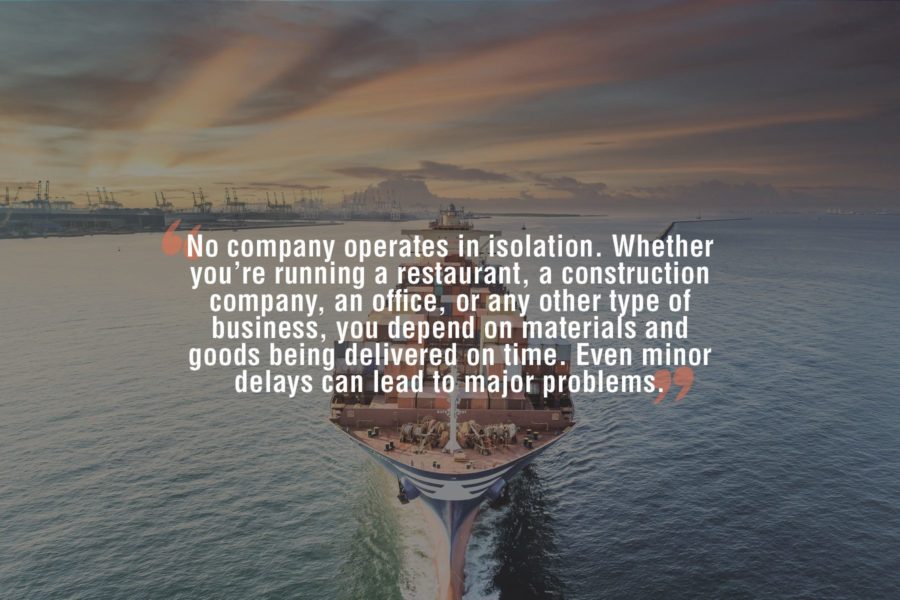No company operates in isolation. Whether you’re running a restaurant, a construction company, an office, or any other type of business, you depend on materials and goods being delivered on time. Even minor delays can lead to major problems.
With supply chain risk management, businesses can anticipate and mitigate common threats. The threats are constantly emerging, however, so supply chain risk management strategies need to adapt.
Here are six new threats to supply chain risk management
1. Cybersecurity and Ransomware
In May, a cyberattack against Colonial Pipeline disrupted fuel deliveries along the East Coast. According to CNBC, the company paid hackers approximately $5 million to get its files back. A little while later, a ransomware attack hit JBS, the world’s largest meatpacker, disrupting production in North America and Australia. Insurance Journal says JBS paid hackers $11 million.
Ransomware is becoming a supply chain nightmare, and according to Computer Weekly, cybersecurity experts say the attacks show no sign of abating. CPO Magazine points out that critical infrastructure has become an attractive target for hackers looking for a quick payment. Food production is especially vulnerable, and an analysis found that 70 percent of companies can be considered “higher risk” because of their security practices. These factors have made cyber liability insurance a necessity for many businesses.
2. Climate Change and Natural Disasters
Natural disasters can cause widespread supply chain disruption, and because of climate change, these disasters may become more common. In fact, it may already be happening.
In 2020, the United States experienced a record-breaking number of weather and climate events resulting in at least $1 billion in losses. The National Oceanic Atmospheric Administration says that there were 22 qualifying disasters, causing $95 billion in combines losses. The disasters include three tornado outbreaks, 10 severe weather events, one drought and heatwave event, one wildfire event and seven tropical cyclones.
2021 didn’t get off to a great start, either. ABC 13 says that the ice storm that hit Texas and other Southern states in early 2021 caused 69 deaths and $18 billion in damage.
Climate change could make hurricanes stronger. It could also exacerbate droughts, extreme weather and wildfires. More and more, companies will need to take these risks into account when assessing supply chain risks.
3. The COVID-19 Pandemic
The COVID-19 pandemic prompted worldwide lockdowns and massive supply chain disruption. According to Accenture, 94 percent of Fortune 1000 companies reported supply chain disruption because of COVID-19, and 75 percent of companies say the pandemic has had a negative or strongly negative impact on business. More than half of companies have downgraded their growth outlooks or plan to do so.
With new vaccines to help in the fight against COVID-19, many people hope to have the pandemic under control soon. However, the effects on the supply chain may take longer to disappear.
There’s also always the risk of another pandemic. It could be a variant of COVID-19, or it could be something else entirely.
4. Materials Shortages
Have you ever gone to the store to buy something but then walked away empty handed because the item was out of stock? Similar issues can happen on a larger scale when shortages mean that companies can’t get the goods and materials they need.
Recently, lumber shortages and price surges have disrupted the construction industry, while a microchip shortage has caused problems for car makers. CNBC says that other types of companies are beginning to feel the impact of the chip shortage, and retailers could face issues in the coming months.
According to Reuters, the Institute for Supply Management conducted a survey and found that “record-long lead times, wide-scale shortages of critical basic materials, rising commodities prices and difficulties in transporting products are continuing to affect all segments.”
5. The Rise of Mega Containerships
The bigger a ship is, the more it can transport. That should be good for the supply chain, right?
Maybe. Maybe not. It’s complicated. Although massive containerships have their advantages, they’re also bringing new problems.
In March 2021, these problems gained worldwide attention when a massive containership became stuck in the Suez Canal, blocking it for six days. CNN says that the ship, the Ever Given, is about as long as the Empire State Building is tall, and it can hold up to 20,000 containers. Although the Ever Given is in the top one percent of global ships in terms of size, mega cargo ships like this are becoming more common, and the container capacity of the biggest ships has doubled in the last decade.
Blocked canals aren’t the only risk created by the rise of mega containerships. According to NPR, these ships are also vulnerable to strong winds that can cause large stacks of containers to fall over and into the sea. A Japanese-flagged vessel lost more than 1,800 containers – about $200 million worth – this way.
Massive containerships may also be contributing to the backlogs that have been plaguing ports recently. According to Business Insider, the Los Angeles and Long Beach ports have been heavily congested for months, meaning that many ships have to wait a long time before they can unload. Kip Louttit, executive director of the Marine Exchange of Southern California, says that huge ships are part of the problem because “they take longer to unload. You need more trucks, more trains, more warehouses to put the cargo.”
6. Increased Complexity
One of the greatest supply chain risks is also one of the hardest to pin down: complexity. As supply chains become more complex, so does supply chain management, risk assessment and risk mitigation.
According to Inbound Logistics, research from APICS and Michigan State University has identified three main contributors to supply chain complexity: customer accommodation, globalization and internal pressures.
Increased globalization means that many items have to travel halfway around the world before they reach a business. As a result, a disruption thousands of miles away can impact your business. Supply chain disruption becomes of matter of when, not if. Add to this the fact that customers and clients expect access to a wide variety of products from around the world – and they expect it fast and conveniently – and it’s easy to see how supply chain complexity can become a problem.
Managing Your Supply Chain Risks
Many of these supply chain issues may get worse in the years to come. Businesses can’t ignore the problem – they need to face it head on with supply chain risk management strategies and a proactive insurance partner.
Our risk management team can help you anticipate, prevent and mitigate potential disruptions to your supply chain. We are a member of Globex International Group, which enables us to provide insurance and risk management services globally.





